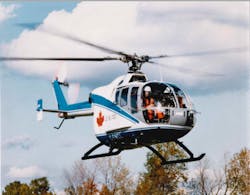PW200 Engine Family Celebrates a Quarter Century of Success
October 1988 marked a new path in the helicopter industry for Pratt & Whitney Canada: the first flight of a PW200 series engine. A twin-engine Bo105LS, powered by the PW205B, from Messerschmitt-Bölkow-Blohm of Germany (MBB), lifted off from Ontario’s Niagara Peninsula. Standing nearby, Canadian and German engineers and technicians applauded as the blue-and-white helicopter climbed into the sky.
Over the following 25 years, the company’s PW200 engine series emerged as the world’s leading powerplant for light twin-engine helicopters. With 620- to 735-shaft horsepower takeoff power, it is well suited for utility, emergency medical services (EMS), offshore, corporate, law-enforcement and paramilitary roles. Fully functional and operable in all flight conditions, it features an electronic engine control (EEC) with full hydro-mechanical backup. The simplicity of its modular design, with only three major rotating components, ensures easy maintenance access. And its low specific fuel consumption, lightweight materials and a compact architecture further enhance its impressive thermodynamic performance.
Follow P&WC
